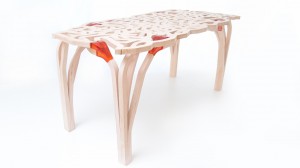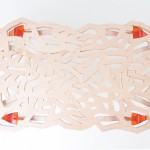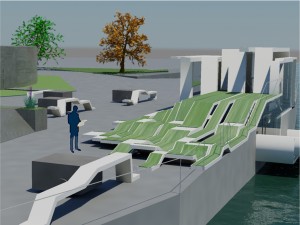The Future of 3D Printing (and Elliot)
 I don’t know if 3D printing will change the world, but I do know that it’s helping Elliot start up a new business in Berlin.
I don’t know if 3D printing will change the world, but I do know that it’s helping Elliot start up a new business in Berlin.
Elliot’s a good designer. He’s designed everything from 3D videos to websites to room dividers to packaging. But he has a special knack for furniture – especially furniture designed on a computer.
Using 3D software Elliot designed the table in the photos. He then built one, using a numerical controls (NC) laser to cut the wood and a 3D printer to create the red resin joints. (You can get them in any color you want).
The design incorporates both additive and subtractive manufacturing. Elliot creates the tabletop by cutting wood away – it’s subtractive. He creates the joints in a 3D printer by adding one layer of resin on top of another repetitively.
Elliot has now rented a studio in Berlin and is starting up a furniture design and manufacturing business, under the brand name Studio Elliot White. None of this would have been possible without 3D design software and printers.
So, is Elliot a harbinger of things to come? Well, maybe. A few days ago the New York Times had a lively discussion on the topic in  its Room For Debate section. Here are some highlights along with my ruminations.
its Room For Debate section. Here are some highlights along with my ruminations.
Big picture – the grand vision has been that we will all have 3D printers in our homes. We could order Elliot’s table (or bench or chair) and he would simply send us the design files for us to print at home. That seems unlikely, at least in the near term. Home printers just don’t produce the necessary quality.
Future schlock – Amazon recently opened its 3D printing store. You can create your own products. Unfortunately, most of it is schlock – like a 3D printed plastic dog bone. Even with such simple products, you don’t get to print it yourself. Amazon prints it and ships it to you.
Jet engine parts – some analysts suggest that 3D printing will always be low quality because of inherent weaknesses in additive technology. But General Electric has figured out how to print fuel nozzles for jet engines by printing layers of metal. By doing so, they reduce costs and lead times while improving quality.
 Clothes – I wouldn’t have thought of printing clothes but start-up companies are pushing the trend. Indeed, the US Army seems to think that it can clothe soldiers in high-tech printed uniforms for greater comfort and safety. And, yes, there is even a range of 3D printed bikinis.
Clothes – I wouldn’t have thought of printing clothes but start-up companies are pushing the trend. Indeed, the US Army seems to think that it can clothe soldiers in high-tech printed uniforms for greater comfort and safety. And, yes, there is even a range of 3D printed bikinis.
Food – yes, it’s possible to print food. I was heartened to learn that one of the first applications is to print chocolate onto other foods.
Guns – yep, printable guns are here. And here. They’re cheap and undetectable. But don’t worry. They can only fire a few bullets before they break.
Manufacturing – could 3D printing return manufacturing to advanced countries? Maybe. As one Room For Debate writer noted, manufacturing productivity has risen much more quickly than overall business productivity. Meanwhile, the cost of labor in China is rising at 10 to 15% per year. If these trends continue, on-shoring makes a lot more sense.
So, what’s the future? Well, once again, I think we’re caught in the hype cycle. The initial hype was intense. Now there’s a bit of disappointment as reality seeps in. But that’s usually followed by a rising productivity curve as entrepreneurs sort out which technologies fit which markets. I’m generally optimistic. Now … does anyone want to buy a table?
Pour Me a House. Print Me a Cookie.

Print this!
When Elliot was in architecture school, he designed a chair in 3D software. Then he printed it. Then he sat in it. It held up pretty well.
As a designer, Elliot was an early adopter of 3D printing, also known as additive manufacturing. Elliot designs an object in 3D virtual space within a computer. (He’s an expert at this). The object exists as a set of mathematics, describing lines, arcs, curves, shapes, and so on.
Elliot then exports the mathematical description of the object to a 3D printer. The printer converts the math into hundreds of very thin layers – essentially 2D slices. The printer head zips back and forth, laying down a slice with each pass to build the product physically. It’s called “additive manufacturing” because the printer adds a new layer with each pass.
The earliest such printers might have been called “subtractive manufacturing.” You started with a big block of wax in the “printer”. You then loaded the mathematical description and the printer carved away the unnecessary wax using very precise cutting blades. The result was the object modeled in wax. You used the model to build a mold for manufacturing.
Elliot used a printer equipped with a laser and some very special powder. Based on the mathematical description of the slices, the laser moved back and forth, firing at appropriate points to build each layer. On each pass, the laser converted the powder into a very strong, very hard resin that adhered to the previous layer. At the end, Elliot had the finished product, not just a mold.
Elliot’s chair looked and felt like it was made of plastic. Several companies are now experimenting with metal oxides that use a similar process to print metal objects. A British company, Metalysys, is working with a titanium oxide that should allow you to print titanium objects. One benefit: it should dramatically reduce the cost of titanium parts and products.
Newer 3D printers can use a nozzle to extrude material onto each slice. What can you extrude? Well, cement, for instance. Construction companies in Europe are already using robotic arms and cement extruders to build complex walls and structures. It won’t be long before Elliot can design an entire house in virtual space and then have it poured on site. Elliot will be able to create much more imaginative designs (like the one above) and print them at a lower cost than traditional building techniques. What a great time to be an architect!
Not interested in cement? How about extruding some cookie dough instead? In fact, let’s imagine that you have some special dietary needs and restrictions. You submit your dietary data to the printer, which selects a mix of ingredients that meets your needs, and prints you a cookie. You can select ingredients based on your tastes as well as your dietary needs. What a great time to be a chef!
What’s next? GE recently announced that it would use additive manufacturing to create jet engine parts. Before long, we may be able to print new body parts. (I’m waiting for a new brain). And, 3D printing is coming to your home. Click here to find out how you can make anything. What a great time to be a nerd!